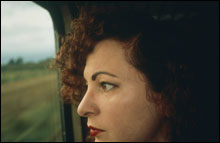The Peabody remains devoted to historical shows (American design, Chinese decorative art, Native American and Thai works, and 150 years of local art in “Painting Summer in New England,” which opens April 22), but this programming is invigorated by exhibits of recent art from the United States, Africa, India, the Caribbean, and the Inuit Arctic. And the renovation and expansion has inspired curators to rethink how they present the permanent collection, mixing old and new as they increasingly favor themes (the lives of men or women, nature, architecture) over chronology.
Sometimes the exhibitions still strike middlebrow National Geographic tones, like the “intimate look at the exclusive world of geisha culture” in 2004. I couldn’t bring myself to visit the recently closed “Artful Teapot” show. And though the installations throughout the complex are exquisite, the ravishing atrium offers few vistas to lure visitors into new surrounding galleries, instead funneling people into the old halls. Curators have begun to address this problem by placing samples from the new galleries in the atrium.

The most surprising development is that a year from now the museum will host a 200-piece Joseph Cornell retrospective, the first in more than a quarter-century. At first blush, Cornell seems far outside the Peabody’s usual Yankee-English maritime trade territory. He had vague local connections (attended Phillips Academy in Andover), but his work was oriented toward his nostalgic dreaming in Queens, New York, and love of things French. Chief curator Lynda Hartigan says the show reflects the museum’s aim to connect past to present, but I suspect it has more to do with allowing her to finish up a project she began while working at the Smithsonian. No matter, the result should be smashing.
It’s often said that if the ICA had retained one work from each of its shows of the past 50 years, it would host an astonishing collection. The initial acquisitions, all gifts, endorse this reasoning by assembling works by artists the ICA has exhibited in the past decade. English sculptor Cornelia Parker’s 1999 Hanging Fire (Suspected Arson), which was exhibited in her 2000 ICA show, is a 12-foot-tall cascade of charred timbers hung from the ceiling by wire, the remains of a house thought maliciously set alight. It’s as if the building had shattered and then frozen in the midst of fluttering to the ground.
 Nan Goldin’s 1988 color photo of a pair of naked men kissing in a Cambridge tub is one of the raw punkish snapshots of family and friends around Boston and New York in the 1970s and ’80s that made her name. They’re distinguished by an unflinching and sometimes unnerving intimacy. (How is she so often there with a camera for such vulnerable moments?) Her work showed people struggling to get by, eking out fun and hard love. Violence — the threat of a lover’s fists — lurked in the corners and sometimes burst to the foreground. A 1992 self-portrait of Goldin staring out the window of a train rushing across Germany and a 1995 snap of a friend squatting atop hills cloaked in white smoke demonstrate how her style has grown more lush and accomplished, more elegiac, over the years while still offering glimpses of the stuff we usually secret away. The quality of the work and her local connections make her an obvious — and necessary — choice for any contemporary Boston collection.
Nan Goldin’s 1988 color photo of a pair of naked men kissing in a Cambridge tub is one of the raw punkish snapshots of family and friends around Boston and New York in the 1970s and ’80s that made her name. They’re distinguished by an unflinching and sometimes unnerving intimacy. (How is she so often there with a camera for such vulnerable moments?) Her work showed people struggling to get by, eking out fun and hard love. Violence — the threat of a lover’s fists — lurked in the corners and sometimes burst to the foreground. A 1992 self-portrait of Goldin staring out the window of a train rushing across Germany and a 1995 snap of a friend squatting atop hills cloaked in white smoke demonstrate how her style has grown more lush and accomplished, more elegiac, over the years while still offering glimpses of the stuff we usually secret away. The quality of the work and her local connections make her an obvious — and necessary — choice for any contemporary Boston collection.
Williamstown painter Laylah Ali’s 1998 gouache Untitled (Greenheads) is from her series of small cartoony scenes of gumball-headed stick figures matter-of-factly torturing one another in front of hospital-blue backdrops. When I first saw them some years ago, they called to mind the hand-to-hand atrocities of Rwanda. Here two figures in matching black masks and green and orange uniforms drag a struggling member of their team away to his doom. This painting would benefit from companions. Ali’s work really needs to be seen in groups if it’s to convey its sinister mystery and evoke the record of some complicated, ritualistic war.
Swiss artist Thomas Hirschhorn is represented by a giant wooden Leaning Tower of Pisa necklace from 2004 that doesn’t capture the awesome messiness of the artist’s “more is more” æsthetic as seen in his ICA show last September or his cardboard-and-packing-tape caves that I toured in a New York gallery in 2002. Rounding out the collection: New Yorker Paul Chan’s animated rumination on September 11, 1st Light, which was shown at the ICA last year and is now in the Whitney Biennial in New York; South African native and now Amsterdam resident Marlene Dumas’s washy 2000 ink-and-acrylic sketch of a German Witch; Lebanese native and now London resident Mona Hatoum’s 2002 Pom Pom City rug; Boston sculptor Taylor Davis’s 2001 pine freight pallet with mirrors inside; and a 1996 Cornelia Parker wedding-ring piece.